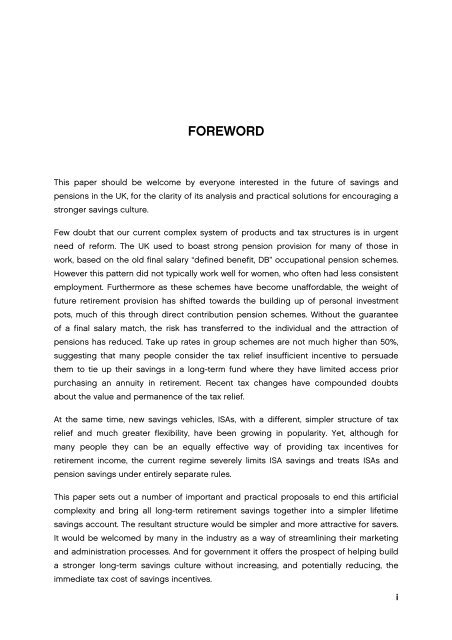Simplification is the key - Centre for Policy Studies
Simplification is the key - Centre for Policy Studies
Simplification is the key - Centre for Policy Studies
You also want an ePaper? Increase the reach of your titles
YUMPU automatically turns print PDFs into web optimized ePapers that Google loves.
FOREWORD<br />
Th<strong>is</strong> paper should be welcome by everyone interested in <strong>the</strong> future of savings and<br />
pensions in <strong>the</strong> UK, <strong>for</strong> <strong>the</strong> clarity of its analys<strong>is</strong> and practical solutions <strong>for</strong> encouraging a<br />
stronger savings culture.<br />
Few doubt that our current complex system of products and tax structures <strong>is</strong> in urgent<br />
need of re<strong>for</strong>m. The UK used to boast strong pension prov<strong>is</strong>ion <strong>for</strong> many of those in<br />
work, based on <strong>the</strong> old final salary “defined benefit, DB” occupational pension schemes.<br />
However th<strong>is</strong> pattern did not typically work well <strong>for</strong> women, who often had less cons<strong>is</strong>tent<br />
employment. Fur<strong>the</strong>rmore as <strong>the</strong>se schemes have become unaf<strong>for</strong>dable, <strong>the</strong> weight of<br />
future retirement prov<strong>is</strong>ion has shifted towards <strong>the</strong> building up of personal investment<br />
pots, much of th<strong>is</strong> through direct contribution pension schemes. Without <strong>the</strong> guarantee<br />
of a final salary match, <strong>the</strong> r<strong>is</strong>k has transferred to <strong>the</strong> individual and <strong>the</strong> attraction of<br />
pensions has reduced. Take up rates in group schemes are not much higher than 50%,<br />
suggesting that many people consider <strong>the</strong> tax relief insufficient incentive to persuade<br />
<strong>the</strong>m to tie up <strong>the</strong>ir savings in a long-term fund where <strong>the</strong>y have limited access prior<br />
purchasing an annuity in retirement. Recent tax changes have compounded doubts<br />
about <strong>the</strong> value and permanence of <strong>the</strong> tax relief.<br />
At <strong>the</strong> same time, new savings vehicles, ISAs, with a different, simpler structure of tax<br />
relief and much greater flexibility, have been growing in popularity. Yet, although <strong>for</strong><br />
many people <strong>the</strong>y can be an equally effective way of providing tax incentives <strong>for</strong><br />
retirement income, <strong>the</strong> current regime severely limits ISA savings and treats ISAs and<br />
pension savings under entirely separate rules.<br />
Th<strong>is</strong> paper sets out a number of important and practical proposals to end th<strong>is</strong> artificial<br />
complexity and bring all long-term retirement savings toge<strong>the</strong>r into a simpler lifetime<br />
savings account. The resultant structure would be simpler and more attractive <strong>for</strong> savers.<br />
It would be welcomed by many in <strong>the</strong> industry as a way of streamlining <strong>the</strong>ir marketing<br />
and admin<strong>is</strong>tration processes. And <strong>for</strong> government it offers <strong>the</strong> prospect of helping build<br />
a stronger long-term savings culture without increasing, and potentially reducing, <strong>the</strong><br />
immediate tax cost of savings incentives.<br />
i

















